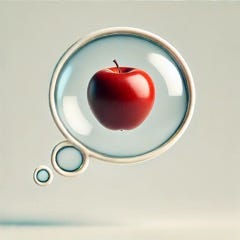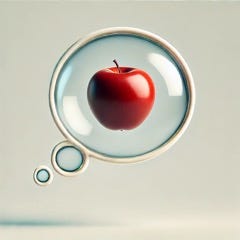Our Inner Visual Lives — Two Ends of the Spectrum
One of us depends on visual memory; the other manages just fine without any at all.
Barbara: It’s been interesting to discover how different we are — in one fairly dramatic way. Your interior mental life is very visual. And I have no mental visual imagery, at all (other than in dreams).
Elizabeth: What you’re saying about yourself is so unimaginable to me, I genuinely find it hard to believe. My initial reaction is that you have a kind of blindness. If you don’t have visual memories, how do you remember anything?
Barbara: I just know things. I know what happened when I was in 5th grade. I know how a tea kettle looks. For me, it’s all conceptual. I don’t have internal visuals of anything, including visual memories.
Elizabeth: Whereas, when I recall a past event, I see a whole scene. The image isn’t precisely photographic. I’m “in” it, so it’s not a record of what I’ve seen but rather a kind of reconstruction. The scene contains all the emotion and meaning of the event, as I experienced it. Essentially the image “holds” the memory.
Barbara: I think what you’re describing are your associations to the event. I have associations, too. I know what I felt, the meaning it had, as I experienced it.
Elizabeth: I realize, as we’re talking, that I need the image as a framework on which to hang everything. For me, an experience is condensed in an image, and without it I think I’d just have a miasma of loose details. In fact, I’m not sure I’d have any memory of events without a picture of them. Maybe it’s this sense of complete dependency that makes it so hard for me to grasp how you manage without seeing your memories.
Barbara: It sounds like your brain uses images to organize the details of a memory. I don’t know how common it is for people to use images to organize their memories. But most people do have visual memories, though they may vary in clarity.
Elizabeth: If you and I are on opposite ends of the ability to generate mental images, what is in between?
Barbara: Less visual veracity. Less clarity. There is a test called the apple test. https://creativerevolution.io/aphantasia-a-blind-minds-eye/
You close your eyes and picture an apple. Then you rate the clarity of what you see on a scale from 1-5. I see darkness. I see nothing at all. I have what is called aphantasia.
Elizabeth: When did you realize this?
Barbara: Not very long ago. Before I recognized this about myself, some things made no sense to me, like when a meditation instructor would say, “Picture yourself on a beach.” Only recently did I realize that other people can actually picture themselves on a beach!
Although I manage very well with this absence of images, I think it has consequences. For instance, in retrospect I realize that the reason I was terrible at organic chemistry was probably because I couldn’t picture the molecules. And when I’m reading, I don’t picture the characters or settings that are being described. The story doesn’t come alive, and I think that’s why I don’t particularly enjoy fiction. So much of my interior mental life is conceptual; that’s likely why I like to write about ideas.
Elizabeth: One of the reasons I’m so amazed at your lack of mental imagery, is that in other ways you’re so visual. You’ve been doing all the DALL-E images for our newsletter, and when we discuss them you zero in on every detail.
Barbara: And, in fact, I am able to see the subtleties in colors, and reading or even drawing floor plans is easy for me. I have all sorts of visual abilities that seem discrepant with having no visual mental images, although they actually depend on different combinations of brain capabilities.
The big message here is that everyone is different — and in ways that may not be the kinds of “different” that people focus on — like introvert/extrovert or novelty-seeking or risk-averse. If we stick with just visual capabilities, some people have trouble with mental arithmetic because they have trouble visualizing the placement of digits. Some people have trouble reading a map that doesn’t correspond with their orientation in space because they can’t rotate images in their mind.
Elizabeth: Now I’m thinking of inconsistencies in my ability to visualize. I can’t spell, because I don’t see the word. I only hear it. Once in college, I couldn’t remember how to spell ‘cute,’ and I looked it up under ‘Q’! I assume that other people visualize words and then just copy down what they see. But is this even true?
Barbara: No, I don’t think it is. You’ve generated a theory about how people learn to spell based on your own strong reliance on visual imagery. Spelling, reading, language…these are all related and neurologically complex.
Elizabeth: The differences in the way you and I experience internal images are particularly extreme, but it must be that all of us think and process information in very different ways. And not realizing that this is so may lead us to make false assumptions about how other people’s minds work.
What about your dreams? You say they are visual.
Barbara: I know that they’re visual in the same way that I know what a kettle looks like without being able to actually picture one in my mind. But on rare occasions when I wake up from a dream, and my eyes are still closed, sometimes, for a nano-second, I actually see the dream image lingering and I’m awake. This is undoubtedly because of a lack of perfect synchrony between the various aspects of REM sleep — including the hallucinations that comprise dreaming and being in a state of sleep. In that moment I know what it’s like for you.
Elizabeth: I’m so moved by that. What kind of experience is it for you?
Barbara: It’s lovely, delicious.
Elizabeth: What about face recognition? I’m terrible at it! When I first meet someone and go to shake hands, I look them in the face and am overwhelmed by all the visual information. I try to focus on their name, as they introduce themselves, but it’s impossible. I can’t even take in how they look.
Barbara: That’s called prosopagnosia — trouble recognizing faces, and it’s a particular, separate brain dysfunction. I have it, too.
You feel overloaded because your brain can’t effectively process the information. It’s not that there is literally too much information. I’ve treated a lot of patients with attentional problems who can’t deal with a grocery store, for example. There’s too much going on, for them. Too many cereals to choose from. And what they experience is what you experience with faces. They feel overwhelmed.
Did you ever wonder at the inconsistency of your being so visually dependent and yet unable to picture faces?
Elizabeth: No, it never occurred to me. I didn’t even realize that my problem with faces was a “thing,” until a few years ago. In fact, I never thought of myself as “visually dependent” until I noticed how I use the images that come to me when I’m writing. You just are what you are. You perceive the world in the only way you can.
Barbara: I totally agree with you. We know about ourselves by contract. Learning about how other people experience themselves and the world adds to the depth of our empathy. But learning about ourselves is useful in making the most of our capacities. For example, how do you use the images your brain generates to inform your writing?
Elizabeth: If an image comes to me when I’m writing, I’ve learned to pay attention to it. I focus on the scene and my associations to it, and eventually a treasure chest of buried emotion opens up. The images are messages from my brain that help me get under the surface of what I’m writing about. What emerges is always a surprise, sometimes an unwelcome surprise, but I force myself to stick with it. There is usually a huge personal benefit at the end.
Barbara: In contrast, I am also focused internally, but on ideas. I get a thrill from hearing about a new way to understand something… and then from exploring and writing about it.
One lesson to take from this, especially for writers, is that, whatever your inner life is like…if you turn your attention to it, you can learn a lot. You can certainly discover more about yourself, but also your reactions provide clues that can inform you about others. This “meta-cognition” is something you can practice and develop. Let’s talk about that next week!
Where are you on the spectrum of an inner visual life? Are your memories visual and do you use them in your creative work? We’d love to know!







I also recently realized that I have no visual memory. Like Barbara, I can't see an apple (or a picket fence in a meditation) but I know what an apple or a picket fence looks like and that's what I rely on.
Wow! Had never thought of this very different approach to one's interior life. Thank you for lifting the veil and sharing.